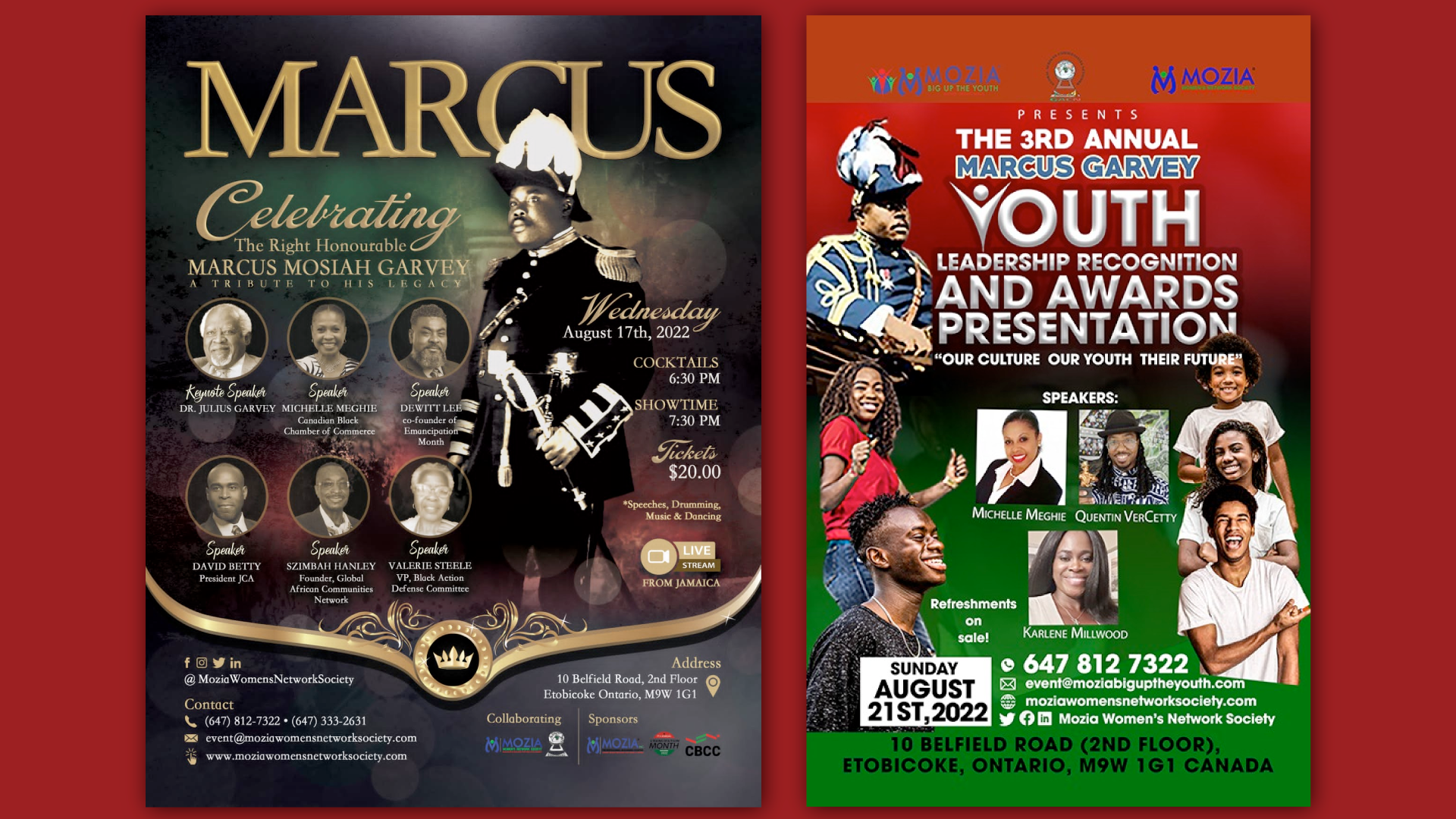on
BY SIMONE J. SMITH
He was a man who believed in political and economic independence. He was a leading figure of the Pan-African movement, which encouraged a return to Africa for people of African descent, and an end to neo-colonial rule on the continent. While his vision and unrelenting efforts led to one of the first movements to unite African’s internationally, he has received criticism, during his life and still to this day, for promoting what some saw as unrealistic ideals and beliefs.
His focus was the independence of African people, racial separatism, and the idea that different races should form physically and geographically separate nations. This idea was criticized by many, including W.E.B. Du Bois and others at the National Association for the Advancement of Coloured People (NAACP), who advocated for interracial efforts towards justice.
Born in Jamaica in 1887, the Honourable Marcus Garvey is the founder of the UNIA. It was formed on the 80th anniversary of the Slavery Abolition Act of the British colonies in Kingston, Jamaica. In order to gain momentum for the organization Garvey moved the UNIA’s headquarters to Harlem, New York in 1916 to gain momentum for the organization. Garvey’s ideas of: empowerment, solidarity, and unity of people of African descent worldwide picked up steam, and UNIA divisions started rapidly opening in various cities across North America, including here in Toronto.
It is why on Wednesday August 17th, 2022, Mozia Women’s Network Society and The Global African Communities Network are collaborating to celebrate the birthday of The Right Honourable Marcus Mosiah Garvey. This initiative is being co-sponsored with the support of: The Emancipation Month Initiative, The Jamaican Canadian Association, The Black Chamber of Commerce and The Black Action Defence Committee.
Their featured guest speaker will be Dr Julius Garvey, the son of Marcus Mosiah Garvey. Dr Garvey will speak on what it means for Heritage Toronto to present him with a commemorative plaque in honour of his father’s historical legacy here in the city of Toronto, and how we as a community can now create a social practice to further honour Garvey’s vision, principles and philosophy.
Following up this event will be the 3rd Annual Marcus Garvey Youth Leadership Recognition Awards Presentation on Sunday August 21st, 2022, which will focus on youth who have excelled in their respective communities. Both events are scheduled to take place at 10 Belfield Road, Etobicoke (2nd Floor).
Marcus Garvey’s Impact in Canada
History has shown that Garvey had very strong ties here in Canada, and his impact was resounding.
Sources vary about the location of the first UNIA division in Canada, but it is said that a division was founded in Cape Breton, Nova Scotia, in 1918 to support West Indian migrants working in mines. The Montreal branch opened in June 1919, and in Toronto, the desire for an organization to unite African people in the face of rampant systemic racism had existed for a few years already.
In April 1919, the Coloured Literary Association was founded; and the West Indian founders would meet in the back room of Occidental Cleaners and Dyers store at 318 Spadina Avenue. It later became a concert hall for many years and is now a CB2 store. Before finding permanent headquarters, UNIA meetings were held in a rented space at 339 Queen Street West, which is now an Arc’teryx store. Several months later, a charter was obtained from the UNIA headquarters in Harlem, and the Toronto UNIA division was officially founded on December 1st, 1919.
After fundraising for many years, members were finally able to purchase a building at 355 College Street in 1925, which remained the UNIA’s until 1982 and later became the long-time location of reggae bar Thymeless. At its peak, the Toronto division had around 200-300 members who engaged in politics, celebrated culture, and fostered what remained a community hub for decades.
The Toronto division had a very significant role in the UNIA’s global network. UNIA regional conferences were hosted in Toronto in 1936, and 1937. As an Emancipation Day celebration, the Toronto UNIA organized the Big Picnic in St. Catherines every year from the 1920s to the 1950s. The picnic drew thousands of attendees from Ontario and New York State every year, and remained a key gathering for Black communities for decades. Garvey attended the annual Big Picnic in 1938.
The Marcus Garvey Centre for Leadership and Education was founded in the Jane and Finch neighbourhood in 2002 to provide leadership development and training to African-Canadian youth, and Marcus Garvey Day is now celebrated on August 17th, and has been since 1993.
The Marcus Garvey Living Legacy Project
I had an opportunity to speak with Simba Hanley, one of the spearheads of The Marcus Garvey birthday celebration, and he filled me in on some exciting news.
“There are some tremendous announcements that the African-Caribbean community can look forward to in the next few years, and personally, I am excited to share them.
In 2019, I had the opportunity to dialogue with Sandi Loytomaki, who I met at a flag-raising event. We began discussing the idea of having a formal ceremonial street rename for Marcus Garvey in Toronto. The concept is to have streets from College St – where the UNIA building was – through University Ave – to join Nelson Mandela Way. This section of streets would be known as ‘Marcus Garvey Way’. At that time, we had the support of one of the city councillors, Mike Layton, who was willing to help us.
We also discussed having social gatherings once a month, and potential workshop/lecture opportunities. These events would allow for fundraising and community development for eventual historical/art installations celebrating and honouring Marcus Garvey and the history of the UNIA.”
Unfortunately, right before the project was to start, COVID-19 shut down the world, and everything was disrupted. The construction that was supposed to begin in 2020 did not happen, thus, the place where the original building was on College St is now a hole with garbage and nature taking over.
“Fortunately,” Brother Hanley shares, “We were able to continue to work with the people that had the UNIA tile, and in February 2020, the tile was delivered to Blackhurst Cultural Centre (formerly A Different Booklist).”
The hope is that The Marcus Garvey Living Legacy Project will be rejuvenated with the visit of Dr Julius Garvey, and community, we all must have a hand in this as well. For more info on tickets and information for the events, call 647-812-7322 or contact us at info@moziawomensnetworksociety.com
Stay in the loop with exclusive news, stories, and insights—delivered straight to your inbox. No fluff, just real content that matters. Sign up today!
We, as humans are guaranteed certain things in life: stressors, taxes, bills and death are the first thoughts that pop to mind. It is not uncommon that many people find a hard time dealing with these daily life stressors, and at times will find themselves losing control over their lives. Simone Jennifer Smith’s great passion is using the gifts that have been given to her, to help educate her clients on how to live meaningful lives. The Hear to Help Team consists of powerfully motivated individuals, who like Simone, see that there is a need in this world; a need for real connection. As the founder and Director of Hear 2 Help, Simone leads a team that goes out into the community day to day, servicing families with their educational, legal and mental health needs.Her dedication shows in her Toronto Caribbean newspaper articles, and in her role as a host on the TCN TV Network.













